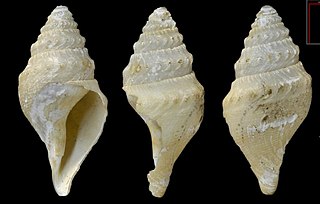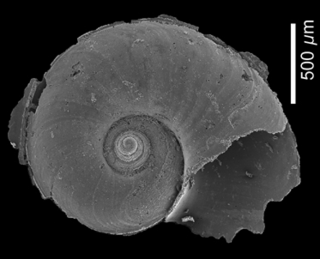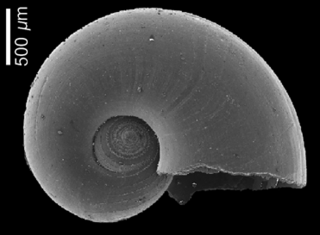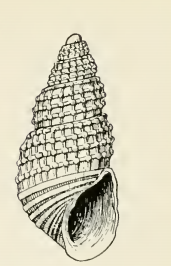
A whorl is a single, complete 360° revolution or turn in the spiral growth of a mollusc shell. A spiral configuration of the shell is found in of numerous gastropods, but it is also found in shelled cephalopods including Nautilus, Spirula and the large extinct subclass of cephalopods known as the ammonites.

The gastropod shell is part of the body of a gastropod or snail, a kind of mollusc. The shell is an exoskeleton, which protects from predators, mechanical damage, and dehydration, but also serves for muscle attachment and calcium storage. Some gastropods appear shell-less (slugs) but may have a remnant within the mantle, or the shell is reduced such that the body cannot be retracted within (semi-slug). Some snails also possess an operculum that seals the opening of the shell, known as the aperture, which provides further protection. The study of mollusc shells is known as conchology. The biological study of gastropods, and other molluscs in general, is malacology. Shell morphology terms vary by species group. An excellent source for terminology of the gastropod shell is "How to Know the Eastern Land Snails" by John B. Burch now freely available at the Hathi Trust Digital Library.

Atlantidae is a family of sea snails, holoplanktonic gastropod molluscs in the clade Littorinimorpha.

Atlanta is a genus of pelagic marine gastropod molluscs in the family Atlantidae. They are sometimes called heteropods.

The Pterotracheoidea is, according to the Taxonomy of the Gastropoda, a taxonomic superfamily of sea snails or sea slugs, marine gastropod molluscs in the clade Littorinimorpha. They are commonly called heteropods or sea elephants.
The following is a glossary of common English language and scientific terms used in the description of gastropods.

Teretiopsis thaumastopsis is a species of sea snail, a marine gastropod mollusk in the family Raphitomidae.

Cryptogemma polystephanus is a species of sea snail, a marine gastropod mollusk in the family Turridae, the turrids.

Choristella leptalea is a species of sea snail, a marine gastropod mollusk in the family Choristellidae.

Carenzia trispinosa is a species of sea snail, a marine gastropod mollusk in the family Seguenziidae.

Nucella lamellosa, commonly known as the frilled dogwinkle or wrinkled purple whelk, is a species of sea snail, a marine gastropod mollusk in the family Muricidae, the murex snails or rock snails. This species occurs in the eastern Pacific Ocean, its range extending in the intertidal zone from the Aleutian Islands southward to central California.

Atlanta brunnea is a species of sea snail, a holoplanktonic marine gastropod mollusk in the family Atlantidae.
Atlanta californiensis is a species of sea snail, a holoplanktonic marine gastropod mollusk in the family Atlantidae.

Atlanta lesueurii is a species of sea snail, a holoplanktonic marine gastropod mollusk in the family Atlantidae.

Oxygyrus keraudrenii is a species of sea snail, a holoplanktonic marine gastropod mollusk in the family Atlantidae.

Protatlanta souleyeti is a species of sea snail, a holoplanktonic marine gastropod mollusk in the family Atlantidae.

Protatlanta rotundata is an extinct species of sea snail, a holoplanktonic marine gastropod mollusk in the family Atlantidae.

Odostomia cooperi is a species of sea snail, a marine gastropod mollusk in the family Pyramidellidae, the pyrams and their allies.

Seguenzia costulifera is a species of extremely small deep water sea snail, a marine gastropod mollusk in the family Seguenziidae.

Carinaria cristata, commonly known as the glassy nautilus, is a species of pelagic marine gastropod mollusc in the family Carinariidae. It is found in the Pacific Ocean and is described as being holoplanktonic, because it spends its entire life as part of the plankton. It was first described by Carl Linnaeus in 1767. Its fragile shell was much prized by early conchologists for their collections, being so rare that it was said to be worth more than its weight in gold.

















